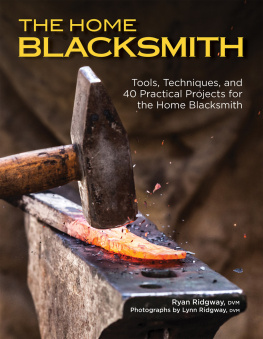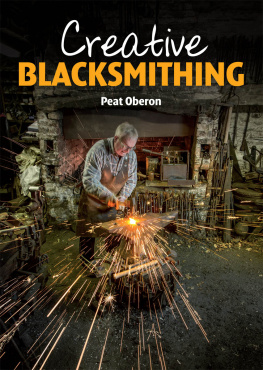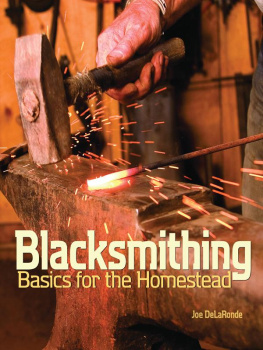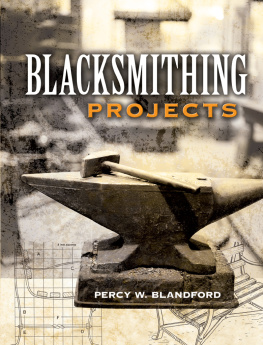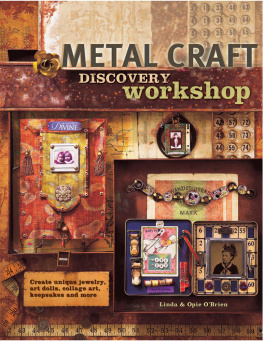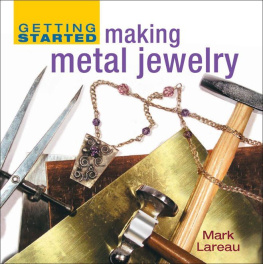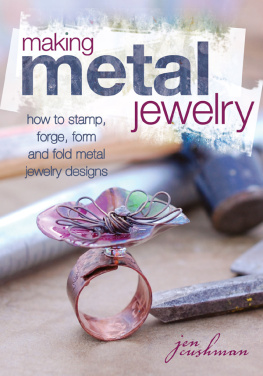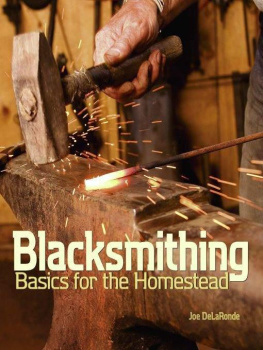Blacksmithing Book for Beginners
Learn How to Forge 15 Easy Blacksmith Projects with Step By Step User Guide Plus Tips, Tools and Techniques to Get You Started
By
Luke Wade
Copyright 2020 Luke Wade
All rights reserved
No part of this publication may be reproduced, distributed, or transmitted in any form or by any means, including photocopying, recording, or other electronic or mechanical methods, without the prior written permission of the publisher, except in the case of brief quotations embodied in reviews and certain other non-commercial uses permitted by copyright law .
Disclaimer
This publication is designed to provide competent and reliable information regarding the subject matter covered. However, the views expressed in this publication are those of the author alone, and should not be taken as expert instruction or professional advice. The reader is responsible for his or her own actions.
The author hereby disclaims any responsibility or liability whatsoever that is incurred from the use or application of the contents of this publication by the purchaser or reader. The purchaser or reader is hereby responsible for his or her own actions.
Table of Contents
Introduction
Chapter 1
Essentials of Blacksmithing
What is Blacksmithing?
History Of Blacksmithing
How Does Blacksmithing Work?
Heating
Hitting
Holding
Shaping
Modernizing Your Blacksmithing Business
Chapter 2
Basic Terminologies In Blacksmithing
Chapter 3
Blacksmithing Tips And Tricks
Basic Tips and Tricks of Blacksmithing
Chapter 4
Getting Started with Blacksmithing
Basic Tools And Supplies You Will Need
Steels
Forge
Hammers
Anvil
Anvil Stand
Tongs
Water Trough/ Quench Tub
Chisel
Vise
Punches
Blacksmithing Safety Rules and Safety Equipment
Setting-up Your Blacksmith Workplace
Basic Blacksmithing Forging Techniques
Chapter 5
Crafting Blacksmithing Projects
S-Hooks
Coat Hook
Punch
Fire Poker
Bottle Opener
Decorative Heart
Decorative Cobra
Leaf Key Chain
Cold Chisel
Froe
Meat Skewers
Nails
Circular Plate
Dinner Bell
Trowel
Chapter 6
Blacksmithing Frequently Asked Questions
Conclusion
Introduction
Metal production is a fast-growing business and industry. It has gone through many stages of advancement, from rough and rugged to easy and classic. One of those rough and rugged forms of metal production that has been around for donkey years is Blacksmithing.
Blacksmithing is an old craft, one of the oldest craft man has ever invented and preserved for years. It is almost as old as agriculture!
Starting in an ancient city by local settlers, it began to spread out into other countries and became a worldwide craft for making metallic tools.
Oh well, I can't really say what was used in place of all the hand tools we have now, but blacksmithing exposed the possibility of making tools from metals and gave importance to unrefined steels.
Well, this has made our lives easier in many ways. Thanks to the early blacksmiths who gave themselves to this discovery.
Blacksmithing, as a craft, can be very technical and stressful. The process requires a degree of smartness, patience, technicalities and creativity. Above all of these, blacksmithing is a highly creative art.
The ability to create has always been in man. Yes, everyone possesses the ability to create and recreate, including you.
Time has proven this! Right from the medieval time when man started producing house tools and utensils from unrefined steels until date, man's creative ability has never been more glaring! Just in case you doubt that. Creativity lives in man.
Not only is it a creative art, but a very inspirational one at that. The stages and processes involved in blacksmithing are also quite inspirational that wise life quotes have been generated from it. Quotes like "not all that glitters is gold" and "strike when it is hot." Smiths worldwide were viewed in medieval times as very honorable men and acknowledged as such to date. In some places in medieval times, they were adored and worshipped. Indeed, it was a deeply honorable art.
Old blacksmiths had several techniques for making metallic products, some of which are still in use today. Some other complex techniques have also been introduced, and we will be discussing each of these techniques in detail, as they determine to a large extent the outcome of your blacksmithing exercise.
The blacksmith has his basic tools of operation like anvil, forge, hammer, chisels, punches, and quench tub. These are very important tools that he cannot do without. This book teaches the use of all these tools and their importance in the blacksmithing process.
The blacksmith's workshop is his sacred shrine where he carries out his operations and should be treated as such.
As a beginner, there are so many smithing codes you will need to get familiar with before you get started. Passion is not enough to make you a blacksmith, neither does a workshop or tool bag. There are basic systems of operation that you need to know by heart before you can make a career of blacksmithing.
This is why I celebrate you for buying this book. Your journey has just started.
This is why we need to preserve this heritage and continue to pass it on. Time and technology must not and cannot steal what our ancient fathers spent their lives building and handed to us; instead, we have to use them as an advantage to build our own career in blacksmithing.
Although the old and crude methods of blacksmithing were highlighted in this book, you can take advantage of the resources that technology has availed us in our time.
There are so many innovations that have been made in place of the crude ones. There are more technical tools that help in forging, shaping and cutting. Hence, making it easier for you to achieve a good result as you would have with a machine. It also makes your work smoother and helps you keep a tidier workplace. The old and conventional way of blacksmithing can be very stressful and demanding.
Today, it is easier and faster for you to make a singular metal than ever. Using these modern tools, you can make in a few hours what would have normally taken all of your time. These tools accelerate the smithing process. However, modernization of tools or not, you can never replace hitting the steel.
Trading as a blacksmith in this time can be quite challenging and difficult. It could seem almost impossible to get sales, especially with machines fully taking over the art of metal production. Nonetheless, it doesn't nullify the relevance of the art at all. Instead, it allows you to prove the uniqueness of the craft.
Keep your passion intact and get ready to journey back and forth into the world of blacksmithing as I expose to you the basics of this incredible art.
Chapter 1
Essentials of Blacksmithing
Do you think that blacksmithing has become obsolete and blacksmiths no longer exist? How wrong you are. The art of blacksmithing has been around for centuries and will continue to forge on as long as people hold on to it and pass down the long-held traditions of this craft.
However, technology seems to have overridden this art and swept it under the carpet. The highly reverenced art of blacksmithing that happened to be one of the most popular trade skills around the 13th century down to the 18th century is now regarded as obsolete due to technology. Technology has introduced sophisticated machines in replacement for manual labor and these machines have proven to be more efficient, hence reducing the demand for blacksmiths.
Next page


